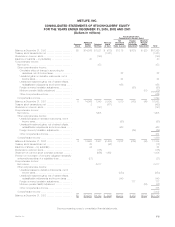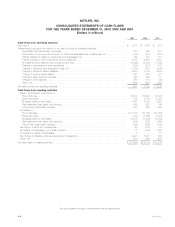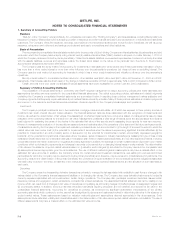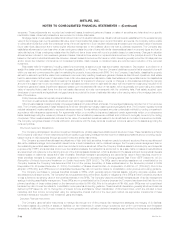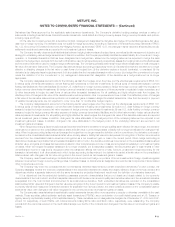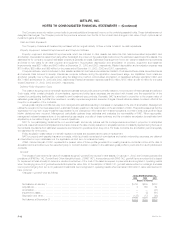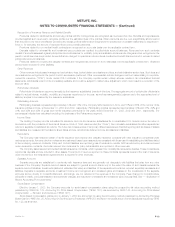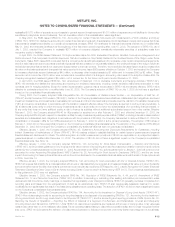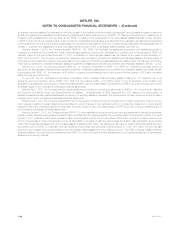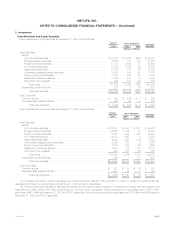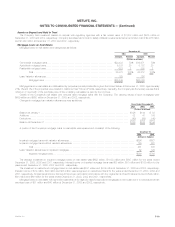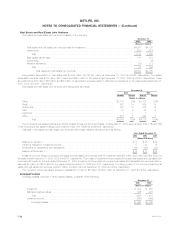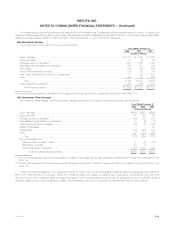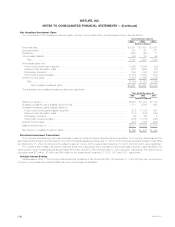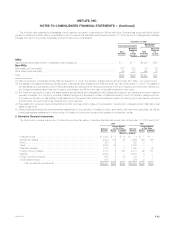MetLife 2003 Annual Report Download - page 60
Download and view the complete annual report
Please find page 60 of the 2003 MetLife annual report below. You can navigate through the pages in the report by either clicking on the pages listed below, or by using the keyword search tool below to find specific information within the annual report.METLIFE, INC.
NOTES TO CONSOLIDATED FINANCIAL STATEMENTS — (Continued)
reclassified $1,678 million of separate account assets to general account investments and $1,678 million of separate account liabilities to future policy
benefits and policyholder account balances. The net cumulative effect of this reclassification was insignificant.
In May 2003, the FASB issued SFAS No. 150, Accounting for Certain Financial Instruments with Characteristics of Both Liabilities and Equity
(‘‘SFAS 150’’). SFAS 150 clarifies the accounting for certain financial instruments with characteristics of both liabilities and equity and requires that those
instruments be classified as a liability or, in certain circumstances, an asset. SFAS 150 is effective for financial instruments entered into or modified after
May 31, 2003 and otherwise is effective at the beginning of the first interim period beginning after June 15, 2003. The adoption of SFAS 150, as of
July 1, 2003, required the Company to reclassify $277 million of company-obligated mandatorily redeemable securities of subsidiary trusts from
mezzanine equity to liabilities.
In April 2003, the FASB cleared Statement 133 Implementation Issue No. B36, Embedded Derivatives: Modified Coinsurance Arrangements and
Debt Instruments That Incorporate Credit Risk Exposures That Are Unrelated or Only Partially Related to the Creditworthiness of the Obligor under Those
Instruments (‘‘Issue B36’’). Issue B36 concluded that (i) a company’s funds withheld payable and/or receivable under certain reinsurance arrangements,
and (ii) a debt instrument that incorporates credit risk exposures that are unrelated or only partially related to the creditworthiness of the obligor include an
embedded derivative feature that is not clearly and closely related to the host contract. Therefore, the embedded derivative feature must be measured at
fair value on the balance sheet and changes in fair value reported in income. Issue B36 became effective on October 1, 2003 and required the Company
to increase policyholder account balances by $40 million, to decrease other invested assets by $1 million and to increase DAC by $2 million. These
amounts, net of income tax of $13 million, were recorded as a cumulative effect of a change in accounting. As a result of the adoption of Issue B36, the
Company recognized investment gains of $9 million, net of income tax, for the three month period ended December 31, 2003.
In April 2003, the FASB issued SFAS No. 149, Amendment of Statement 133 on Derivative Instruments and Hedging Activities (‘‘SFAS 149’’).
SFAS 149 amends and clarifies the accounting and reporting for derivative instruments, including certain derivative instruments embedded in other
contracts, and for hedging activities. Except for certain implementation guidance that is incorporated in SFAS 149 and already effective, SFAS 149 is
effective for contracts entered into or modified after June 30, 2003. The Company’s adoption of SFAS 149 on July 1, 2003 did not have a significant
impact on the consolidated financial statements.
During 2003, the Company adopted FASB Interpretation No. 46 Consolidation of Variable Interest Entities — An Interpretation of ARB No. 51
(‘‘FIN 46’’) and its December 2003 revision (‘‘FIN 46(r)’’). Certain of the Company’s asset-backed securitizations, collateralized debt obligations, structured
investment transactions, and investments in real estate joint ventures and other limited partnership interests meet the definition of a variable interest entity
(‘‘VIE’’) and must be consolidated, in accordance with the transition rules and effective dates, if the Company is deemed to be the primary beneficiary. A
VIE is defined as (i) any entity in which the equity investments at risk in such entity do not have the characteristics of a controlling financial interest, or
(ii) any entity that does not have sufficient equity at risk to finance its activities without additional subordinated support from other parties. Effective
February 1, 2003, the Company adopted FIN 46 for VIEs created or acquired on or after February 1, 2003 and, effective December 31, 2003, the
Company adopted FIN 46(r) with respect to interests in entities formerly considered special purpose entities (‘‘SPEs’’), including interests in asset-backed
securities and collateralized debt obligations. In accordance with the provisions of FIN 46(r), the Company has elected to defer until March 31, 2004 the
consolidation of interests in VIEs for non SPEs acquired prior to February 1, 2003 for which it is the primary beneficiary. The adoption of FIN 46 as of
February 1, 2003 did not have a significant impact on the Company’s consolidated financial statements. The adoption of the provisions of FIN 46(r) at
December 31, 2003 did not require the Company to consolidate any additional VIEs that were not previously consolidated.
Effective January 1, 2003, the Company adopted FIN No. 45, Guarantor’s Accounting and Disclosure Requirements for Guarantees, Including
Indirect Guarantees of Indebtedness of Others (‘‘FIN 45’’). FIN 45 requires entities to establish liabilities for certain types of guarantees and expands
financial statement disclosures for others. The initial recognition and initial measurement provisions of FIN 45 are applicable on a prospective basis to
guarantees issued or modified after December 31, 2002. The adoption of FIN 45 did not have a significant impact on the Company’s consolidated
financial statements. See Note 12.
Effective January 1, 2003, the Company adopted SFAS No. 148, Accounting for Stock-Based Compensation — Transition and Disclosure
(‘‘SFAS 148’’), which provides guidance on how to apply the fair value method of accounting and use the prospective transition method for stock options
granted by the Company subsequent to December 31, 2002. As permitted under SFAS 148, options granted prior to January 1, 2003 will continue to be
accounted for under Accounting Principles Board (‘‘APB’’) Opinion No. 25, Accounting for Stock Issued to Employees (‘‘APB 25’’), and the pro forma
impact of accounting for these options at fair value will continue to be disclosed in the consolidated financial statements until the last of those options vest
in 2005. See Note 14.
Effective January 1, 2003, the Company adopted SFAS No. 146, Accounting for Costs Associated with Exit or Disposal Activities (‘‘SFAS 146’’).
SFAS 146 requires that a liability for a cost associated with an exit or disposal activity be recorded and measured initially at fair value only when the liability
is incurred rather than at the date of an entity’s commitment to an exit plan as required by EITF Issue No. 94-3, Liability Recognition for Certain Employee
Termination Benefits and Other Costs to Exit an Activity Including Certain Costs Incurred in a Restructuring (‘‘EITF 94-3’’). The Company’s activities subject
to this guidance in 2003 were not significant.
Effective January 1, 2003, the Company adopted SFAS No. 145, Rescission of FASB Statements No. 4, 44, and 64, Amendment of FASB
Statement No. 13, and Technical Corrections (‘‘SFAS 145’’). In addition to amending or rescinding other existing authoritative pronouncements to make
various technical corrections, clarify meanings, or describe their applicability under changed conditions, SFAS 145 generally precludes companies from
recording gains and losses from the extinguishment of debt as an extraordinary item. SFAS 145 also requires sale-leaseback treatment for certain
modifications of a capital lease that result in the lease being classified as an operating lease. The adoption of SFAS 145 did not have a significant impact
on the Company’s consolidated financial statements.
Effective January 1, 2002, the Company adopted SFAS No. 144, Accounting for the Impairment or Disposal of Long-Lived Assets (‘‘SFAS 144’’).
SFAS 144 provides a single model for accounting for long-lived assets to be disposed of by superseding SFAS No. 121, Accounting for the Impairment
of Long-Lived Assets and for Long-Lived Assets to be Disposed Of (‘‘SFAS 121’’), and the accounting and reporting provisions of APB Opinion No. 30,
Reporting the Results of Operations — Reporting the Effects of Disposal of a Segment of a Business, and Extraordinary, Unusual and Infrequently
Occurring Events and Transactions (‘‘APB 30’’). Under SFAS 144, discontinued operations are measured at the lower of carrying value or fair value less
costs to sell, rather than on a net realizable value basis. Future operating losses relating to discontinued operations also are no longer recognized before
they occur. SFAS 144 (i) broadens the definition of a discontinued operation to include a component of an entity (rather than a segment of a business);
MetLife, Inc. F-15


